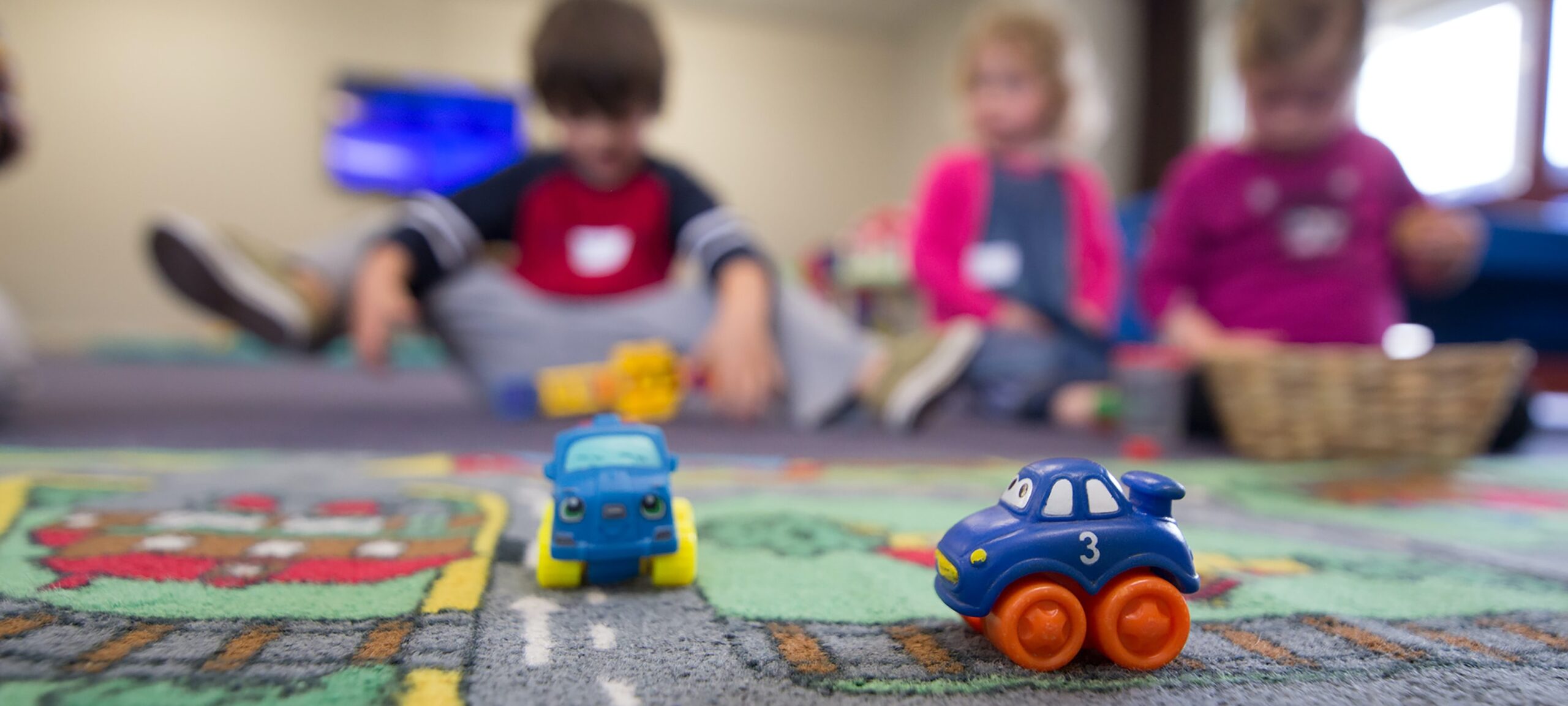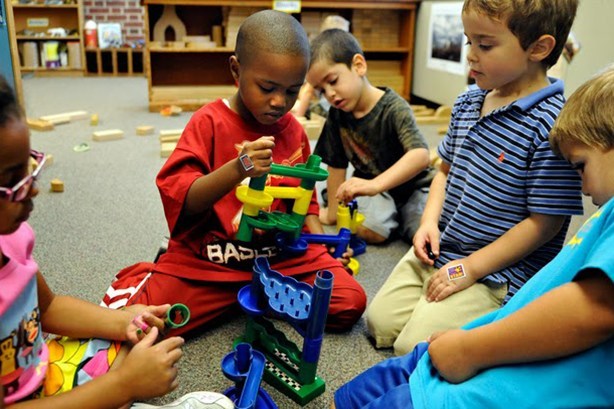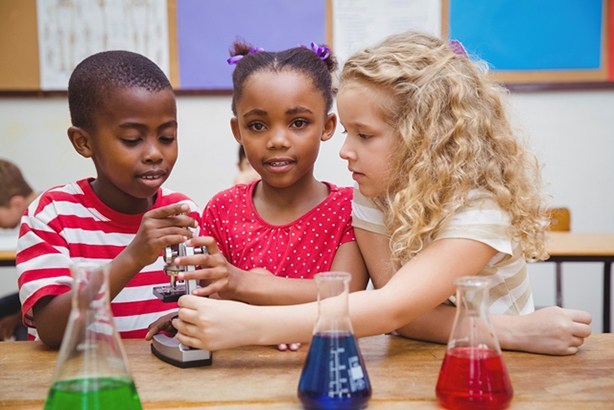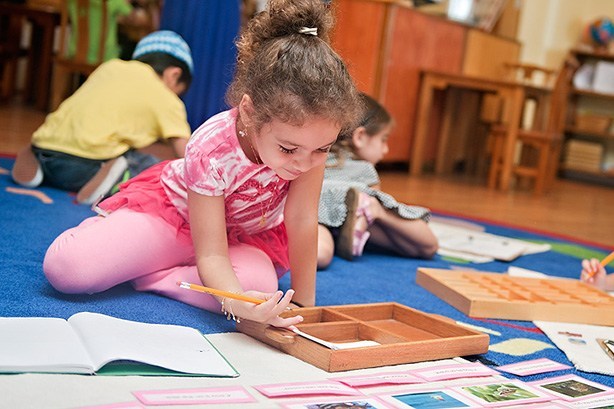
Preschool - Early Childhood Program
One basic idea of the Montessori philosophy is that carried unseen with each child is the person that child can become. To develop his/her physical, intellectual and spiritual powers to the fullest, the child must have freedom–a freedom achieved through order and self discipline. The child’s world is full of sights and sounds which at first appear chaotic. From this chaos the child gradually creates order and learns to distinguish among the impressions that assail his/her senses, slowly gaining mastery of self and of her/his environment.
Dr. Montessori developed what she called “the prepare environment.” Among its features is an ordered arrangement of learning materials in a non-competitive atmosphere which helps each child develop at his/her own rate.
“Never let the child risk failure until he has a reasonable chance of success,” said Dr. Montessori, understanding the need to acquire basic skills before participating in a competitive learning situation. The years between three and six are those when a child learns the ground rules of human behavior most easily. These years can be devoted constructively to preparing the child to take her/his place in society through the acquisition of good manners and habits.
Children who have had the benefit of a Montessori environment are more free later to devote themselves to the development of their intellectual faculties. The method by which children are taught in the Montessori school might be called “programmed learning.” Its structure involves the use of many materials with which the child may work by her/himself. The teaching materials are designed to test understanding and to correct the child’s errors at every step.
Dr. Montessori recognized that self-motivation is the only valid impulse to learning. Children move themselves toward learning. The teacher prepares the environment, programs the activities, functions as the reference person and exemplar, and offers the child stimulation. But it is the child who learns, motivated through the work itself, to persist in his/her chosen task. The Montessori child is free to learn because he/she has acquired an “inner discipline” from exposure to both the physical and mental order. This is the core of Montessori’s educational philosophy. Habits of concentration, stick-to-itiveness, and thoroughness established in early childhood produce a confident and competent learner in later years. Historically, schools have taught children to observe, to think, to judge. Montessori introduces children to the joy of learning at an early age and provides a framework in which intellectual and social discipline go hand in hand.
The Montessori Method emphasizes the importance of Montessori insights for children of all ages, and adults. Although traditionally children begin Montessori education at about two, the principles of self-motivated learning apply to all learning experiences. Modern research has validated Dr. Montessori’s principles of programmed learning and of the non-teacher (one who does not distort or inhibit the learning experience). Many public, private and parochial elementary and secondary schools now use this approach.
Contact Us to Know more.

Montessori Method

Nature Based

Play Based
The Montessori Classroom
The prepared environment is designed by an adult in advance of the child’s entrance. Its aim is to render the growing child independent of the adult. This environment is a place where the child begins to direct his or her own life and in so doing, becomes conscious of his or her own powers.
The apparatus in the classroom can be divided into three areas: practical life, sensorial exercises and learning materials. Practical life activities such as washing tables, dusting, polishing shoes and silver, folding clothes, buttoning and zippering promote mastery of the child’s self and his or her environment. The sensorial materials are designed to provide the child with concepts of dimension, color, shape, sound, etc. By the paring of similar objects and the recognition of contrasts, discrimination becomes evident. Examples of sensorial apparatus are sets of cylinders that vary in height and diameter, sandpaper boards that contrast roughness and smoothness, colored tablets that match colors and others that vary in degrees of tint, and wood tablets that differ in weight.
Sensorial education can be defined as trying to educate the senses, not trying to make the child see better, but to help him know what he sees. By giving first strongly contrasted sensation, and then various graded series (i.e., first red and blue, then several shades of blue), we are teaching him what is red and what is blue, and at the same time, he is learning to compare, contrast, and discriminate. The child learns to distinguish different sense impressions and to put them in some sort of order. This is the beginning of conscious knowledge of the environment as opposed to the unconscious knowledge he has already. As the child begins to isolate these qualities mentally, he is gradually building up concepts of abstractions.
The third category can be defined as learning apparatus, which can be further categorized into math, language and science/ botany. Some examples are the movable alphabet, red and blue counting rods, decimal materials, puzzle maps and biological forms.
Dr. Montessori designed her prepared environment for children of 2 1/2 years to 6 years. The child’s main purpose at this stage is “to conduct himself.” Because he is left free to accomplish the task, he is able to develop to his full potential in the prepared environment.
Nature Based Learning
Our garden and play areas, along with highly skilled educators, allow children to learn through exploration of their natural environment. As dedicated educators we realize learning takes place both inside and outside of the classroom. Our teachers use every opportunity to teach our students about their natural surroundings including plant life and care, trees, insects, animals and building materials for play and exploration to enhance the preschool learning experience. We strive to create lessons based on child interests in the outdoors and have multiple learning opportunities for small group activities, music and play.
Learning Through Play
Our pre-schooler’s engage with one or more peers in the more complex and elaborate form of imaginary play called “sociodramatic” play. In this type of play, children cooperate with one another to create a story and “script,” assume various roles, figure out appropriate “costumes” and “props,” and negotiate new ideas for play, such as, “I want to be a wolf, not a dog!”. Because imaginary play holds such rich potential for promoting children’s cognitive, linguistic, social, and physical development, our program recognizes play as a key element of the curriculum. Children’s spontaneous play is a window into their ideas and feelings about the world. As such, it is a rich source of ideas for curriculum planning and development.
While involved in play, children are challenged to meet the language, problem solving, and social competencies of their peers. When play is interesting and important to children, they are eager to learn the new vocabulary, new physical skills, and new social behaviors that will allow them to stay engaged in play and the days lessons.

Contact us
We'd love to hear from you. Call or email us to learn more or schedule a tour of our school.
Address: 17102 Marda Ave, Yorba Linda, CA 92886
Phone: (714) 996-7463
E-mail: [email protected]
